Writing Through Campus: A Penned Tour of the St. John’s, Annapolis Dorms
March 16, 2022 | By Wyatt Sweeney (A23)
At St. John’s College, the books, conversations, Johnnie chairs, and seminar tables tend to garner most of the spotlight. But just as important to the student experience are the dormitories, where Johnnies who live on campus spend much of their time. With buildings ranging in construction date from the 1800s to 2008, the St. John’s Annapolis dormitory buildings have plenty of stories to tell—hear what they have to say with this written tour by student Wyatt Sweeney (A23), and for geographical reference, check out this campus map.
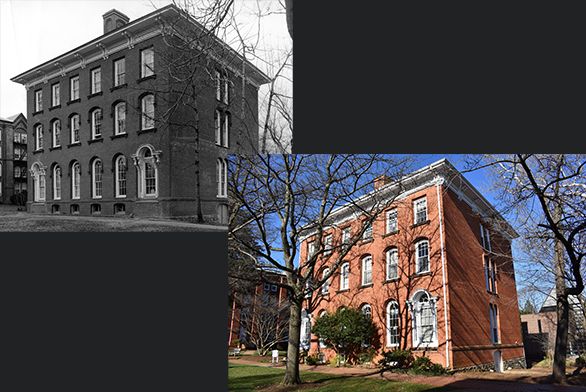
Chase-Stone
Stepping into Chase-Stone, a fairly secluded dorm building some distance from the Annapolis campus quad but fairly close in proximity to the Barr-Buchanan Center, feels a little like entering the underground lair of some group of beatnik poets from a bygone age. The most immediate set of rooms creates the commons of the dorm, which students have come to affectionately call the “Chasement” and are furnished mostly by large, comfortable leather furniture which displays the kind of worn-in appeal one can find in any of the antique shops on Maryland Avenue. The brown leather couches yield comfortably to the weight of a student intent on relaxing into an evening of conversation or a leisurely night of study. The main sitting room is decorated with the characteristic orange of the college, and studies of various flora and fauna hang from the walls, oftentimes alongside student artwork—perhaps visual leftovers from an impromptu art exhibition or a more casual social affair. A sizeable coffee table hosts a small assortment of wooden blocks and some books of photography for students’ perusal, and small sets of stairs branch out into the other sections of the common area. A large fireplace accentuates the homely feel of the room, and students on many occasions will have fires in the winter months as a cozy reprieve from the cold and vigor of their coursework.
An adjacent corridor hosts a vending machine and a bike rack on one end, and a shuffleboard set spans the corridor’s entirety, while a small high-rise table and stools give space for study and are located conveniently close to a drinking fountain. On the opposite side of the main sitting room is another corridor which allows access to the bathrooms and microwave, as well as the small room where the croquet team keeps their equipment for play, plus the laundry room used by both dorm buildings on this particular side of campus.
The rooms of the dorm themselves are accessed through old stone staircases that seem remarkably similar to how one imagines they must have looked in the early ‘40s, shortly after the house was converted from a fraternity to a dormitory in 1939 by Stringfellow Barr. The corridors of the dorm building are narrow, with large chalkboards often containing notes from students, scribblings of amateur artists, and announcements from RAs. The rooms are spacious, with high ceilings and accommodating floor plans. The windows, too, are high and curtained with lavish linens, providing excellent views of the frontmost part of campus.
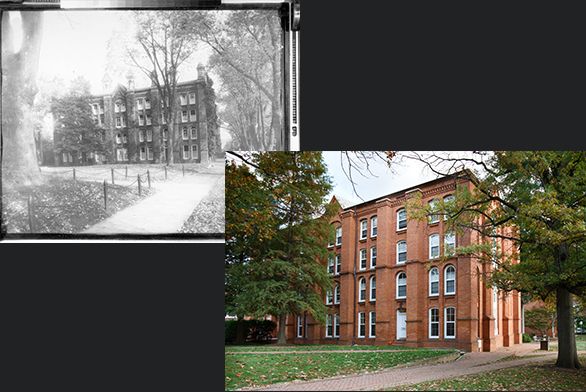
Pinkney Hall
Nearby, Pinkney Hall’s many windows peer out like rows and rows of eyes keeping watch over the small courtyard connecting the two dorms with the Health Center and a parking lot. Pinkney—named for William Pinkney, the Attorney General and minister to both Russia and England during the presidency of James Madison—was built shortly before the Civil War and first housed students shortly after the war’s conclusion, when the student population began to swell once again. It is distinctive for its lack of a common space, though this by no means should indicate how well the students connect with each other in the building. The hallways of Pinkney are often filled on Monday and Thursday nights with students chatting about the various details of their seminars, and the four-room pods at the ends of the upper three floors sometimes see a chair or two occupied by a student looking out through the tall windows at the ends of the halls. The rooms give the intimate feeling of a meditative space, with gorgeous hardwood floors bearing the marks of several generations of students. The bookshelves, which are built into the walls, are situated high off the ground and can hold plenty more than the Program books of a given year, and while the closets might seem slightly claustrophobic to the fashion-conscious Johnnie, the built-in vanity mirror and drawers should give such students solace in their living space.
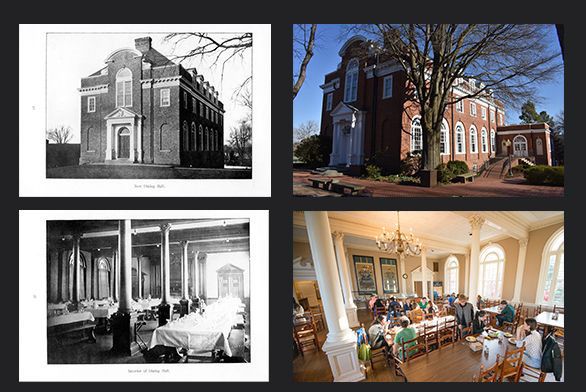
Randall Hall
Moving closer to the quad, Randall Hall is easily the most often-visited dorm on campus, mostly because it’s the building which houses the dining hall. The façade is among the most distinctive at the college: two tremendous pillars on a raised porch frame a large lamp suspended from three large chains above the tall, heavy doors of the building, while a long ramp runs off to the right of the porch into the dining hall itself. The porch and interior of the hall combine Baroque and Georgian styles of architecture, while the recently renovated hallways seem almost jarringly modern. The main vestibule of the dorm is vast in its height, with a large chandelier hanging above a carpeted staircase ascending all the way up to the topmost floor. An eclectic array of Art Deco furniture gives a sense of the lavishness of the common rooms of the dormitory: Most particularly, the third floor’s common room boasts a wide-screen television and furniture festooned in the college’s trademark orange and black. The dorm rooms themselves, housing exclusively female students, are marvelously spacious and comfortable.

Campbell Hall
Directly across the space of the quad is Campbell, another dorm building which predominantly houses freshmen and seems much larger on the inside than the exterior might suggest. The floors of Campbell Hall, built in 1954 and named for an alum of the class of 1793, are dimly lit stretches of linoleum with rooms that can seem a little compressed at first, but ultimately will reward the student who can judiciously arrange their furniture. I personally advise setting one’s bookshelf atop one’s desk and pushing this entire structure against a wall. The basement of the building contains a range of amenities: a kitchen, a laundry room, a common room, and several vending machines. This past year, the kitchen-common room pairing hosted a Thanksgiving supper for several particularly celebratory freshmen.
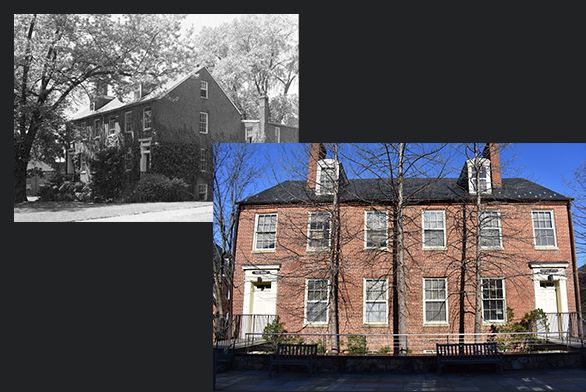
Paca-Carroll House
Far removed from the traditional bustle of the quad, the Paca-Carroll House is next on our little tour of the campus. This building is a sort of hodge-podge of corridors, staircases, and windowed hallways that might at first seem intimidatingly arcane, but most Johnnies tend to get the hang of its labyrinthine layout quickly. The rooms of Paca are some of the largest, primarily because there are a lot of students doubling up in the dorm. Many doubles of the dorm have dividers, turning one dorm room into two adjacent living spaces and allowing residents privacy while preserving the immediacy of one’s roommate. Some students are fortunate enough to live in a loft room, providing two levels for the roommates of such a space to share. The entire dorm, built first as a duplex in 1857, is a medley of various architectural styles, though the original house appears to be built in the Federal style commonly associated with other parts of Annapolis.
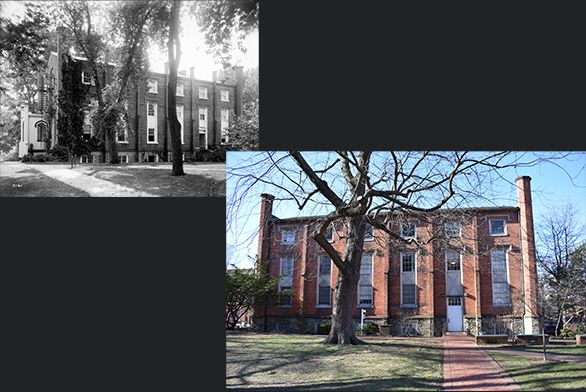
Humphreys Hall
Humphreys Hall, situated near Campbell and in front of Paca, has great value to any antiquarian Johnnie, or any student who’s wanted to shoot an amateur episode of Ghost Hunters. Built in 1835, Humphreys has served as many things: Initially a dorm hall, it was then used as a building for science classes, and, as many students with ghoulish gleefulness will volunteer, it also was purported to be a hospital and morgue during the Civil War. If one desires to see the original foundations of the building from before its 1958 remodeling, simply descend the staircase leading through the “moat” of the hall and enter the college bookshop, where, among the shelves of Program authors, one can still see the salmon-colored brickwork and rounded arches which provided support to the building from its earliest days.
The dorms themselves are easily some of the loftiest on campus and are mostly used by freshmen. As with Campbell and Randall, the immediacy to the quad and to McDowell Hall are some of the major appeals of the real estate, and the rooms themselves are handsomely outfitted. The common room is vast and at one point housed a foosball table and television, which has hosted watch parties for the Oscars, football games, and more.
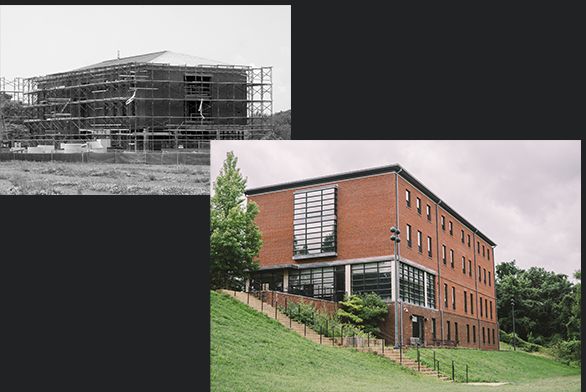
Spector and Gilliam Halls
Finally, there are the two buildings situated on the extremity of back campus, named Spector and Gilliam Halls. These two dorms are collectively referred to by students as “the suburbs” and are by far the most modern: Gilliam was built in 2004, and Spector was built in 2005. These dorms might look a little out of place, given the contemporary architecture, and they are pretty well removed from the rest of campus. This should not, however, make a student living in either dorm feel as though they’re given the short end of the stick. Both buildings feature modern geothermal heating and spacious common rooms, each with an adjoining kitchen. Additionally, the basement of Gilliam has laundry facilities for students, and most of the floors in the two buildings have some rudimentary sink-and-microwave setup for the midnight snacker or would-be host of a gathering of students. The two dorms share another courtyard, which features a fabulous view of College Creek at every hour of the day. One of the largest student parking lots is also just behind both buildings. The rooms are fairly straightforward in layout; usually a desk sits beneath fixed bookshelves near the closet, which is also built into the wall and has adjoined shelving for whatever students might need.

